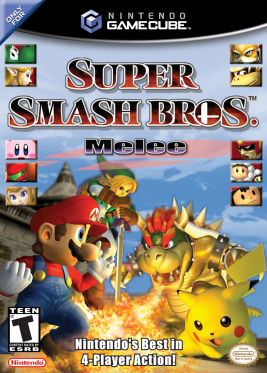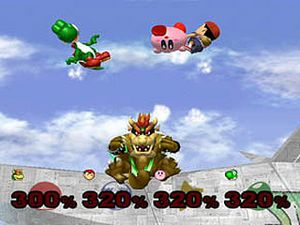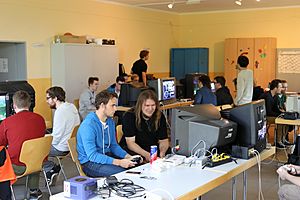Super Smash Bros. Melee facts for kids
Quick facts for kids Super Smash Bros. Melee |
|
|---|---|

North American box art
|
|
| Developer(s) | HAL Laboratory |
| Publisher(s) | Nintendo |
| Director(s) | Masahiro Sakurai |
| Producer(s) |
|
| Designer(s) |
|
| Programmer(s) | Yoshiki Suzuki |
| Artist(s) | Hitoshi Kobayashi |
| Composer(s) |
|
| Series | Super Smash Bros. |
| Platform(s) | GameCube |
| Release date(s) |
|
| Genre(s) | Fighting |
| Mode(s) | Single-player, multiplayer |
Super Smash Bros. Melee is a popular video game for the Nintendo GameCube. It's known in Japan as Dairantō Sumasshu Burazāzu Derakkusu, which means Great Melee Smash Brothers Deluxe. In this game, players pick characters from famous Nintendo games and have them fight each other.
You can play alone or team up with friends. This game is the second in the Super Smash Bros. series. It came after the first Super Smash Bros. for the Nintendo 64. The game that came after Melee was Super Smash Bros. Brawl for the Wii.
Melee includes all the characters from the first game. It also adds new characters from other series like Fire Emblem. The game first came out in Japan in November 2001. It then came to the Americas in December 2001. Europe and Australia got it in May 2002.
Many critics loved Melee. They praised its graphics, easy controls, fun gameplay, and music. It won many awards and is now seen as one of the greatest video games ever made.
It became the best-selling GameCube game. By 2008, over seven million copies were sold. Melee is also very popular in competitive gaming. Its fast and exciting gameplay makes it a favorite for tournaments. It has a big fan community that still plays it today.
Contents
How to Play
Super Smash Bros. Melee is different from most fighting games. Your goal is to knock your opponents off the stage. Each character has a damage meter that shows how much damage they've taken. This is shown as a percentage.
The higher the percentage, the farther you get knocked back. This makes it easier to get knocked off the stage. If you fall off, you lose a "stock" or life.
Most moves in Melee are easy to do. You just press one button and move the joystick. For example, moving the joystick to the side and pressing "B" does a "side special" attack. Moving the joystick up, down, or not at all with "B" does other special moves.
Items and Stages
During battles, items from Nintendo games appear on the stage. These items can hurt opponents or heal you. Some items can be thrown, like a ranged weapon. Others do damage up close, like a bat. Some items change your character instantly.
Most stages are based on Nintendo games or series. They are also interactive. For example, the Mushroom Kingdom stage is from Super Mario Bros.. The Temple stage is from The Legend of Zelda. Even though the stages look 3D, characters only move on a flat, 2D path.
Not all stages are available at first. You have to unlock some stages by completing certain challenges. Some stages have moving parts and dangers that can hurt players. Others are simpler.
Single-Player Mode
In single-player mode, you face many challenges alone. "Classic Mode" lets you fight many opponents and a boss. "Home Run Contest" is a mini-game where you try to hit a sandbag as far as possible. You use a Home Run Bat for ten seconds.
Some modes are special for each character. For example, "Target Test" gives each character a unique area. Here, they try to destroy ten targets as fast as they can. These areas often have hints about the character's story.
"Adventure Mode" takes you through different worlds from Nintendo games. "All-Star Mode" is an unlockable challenge. You must defeat every character in the game. You only have one life and a few health items for all battles.
Multiplayer Mode
In multiplayer mode, up to four players can fight. You can play against each other or on teams. You can also add computer-controlled characters. Their difficulty ranges from one (easy) to nine (hard).
Players can also have a "handicap." A higher handicap makes a player stronger. There are different ways to win a multiplayer match.
- Time mode: The player or team with the most knockouts and fewest falls wins after a set time.
- Stock mode: The last player or team with lives remaining wins.
- Coin mode: The player with the most coins wins. You get coins by hitting enemies. You lose coins if you fall off the stage. Harder hits make more coins appear.
You can also change other options. For example, you can decide how many and what types of items appear during the battle.
Trophies
You can collect trophies throughout the game. These are like little statues of Nintendo characters and objects. They include playable characters, their items, and even characters not in the game. Some trophies are well-known, while others are rare. Some are even from games only released in Japan.
Playable Characters
Super Smash Bros. Melee has 25 characters. If you count Zelda and Sheik as separate, it's 26. This is 13 more characters than the first game. Fourteen characters are ready to play when you start. You need to complete special tasks to unlock the other 11 characters.
Every character comes from a popular Nintendo game series. Each character has a symbol behind their damage meter. This symbol shows their series. For example, Link has a Triforce symbol. A Poké Ball is behind a Pokémon species.
Some characters were not well-known outside Japan when the game came out. Marth and Roy are from the Fire Emblem series. Their appearance in Melee helped make Fire Emblem popular worldwide.
The game also shows how characters from the same world are connected. In one challenge, Mario must defeat Bowser to save Princess Peach. Each character also has moves from their original games. For example, Samus uses her firearms from the Metroid series. Link uses his many weapons.
Making the Game
Super Smash Bros. Melee was made by HAL Laboratory. Masahiro Sakurai was in charge of making the game. It took 13 months to develop, starting in late 2000. Sakurai said he worked very hard during this time, with almost no days off.
The first Super Smash Bros. was an experiment. But for Melee, Sakurai felt a lot of pressure to make a great sequel. He called it "the biggest project I had ever led." Even with the stress, Sakurai later said Melee was "the sharpest game in the series." He felt it was "really good to play."
On the game's Japanese website, Sakurai and the developers explained why certain characters were chosen. They also said why some characters were not added. For example, they first wanted to replace Ness with Lucas from Mother 3. But they kept Ness because Mother 3 was delayed.
Other game creators, like Hideo Kojima (Solid Snake) and Yuji Naka (Sonic the Hedgehog), asked Sakurai to include their characters. But the game was too far along in development. These characters were later added in Super Smash Bros. Brawl.
Marth and Roy were first planned only for the Japanese version of Melee. But they were very popular when the game was being prepared for North America. So, the developers decided to include them in the Western version too.
Nintendo showed a playable version of Melee at the Electronic Entertainment Expo 2001. They also had a tournament at Spaceworld in August 2001. Winners received a GameCube and Super Smash Bros. Melee. Before the game came out, the Japanese website shared weekly updates. These included screenshots and character details.
In January 2003, Melee was re-released as part of the Player's Choice program. This program promotes games that have sold over a million copies. In August 2005, Nintendo even sold the game bundled with the GameCube for $99.99.
Competitive Play
Super Smash Bros. Melee is a very popular competitive video game. It has been featured in many big tournaments. Many players think it's the best Smash Bros. game for competition.
The first Melee tournament was called Premium Fight in Japan in 2001. This started a trend of local tournaments. Players, called "smashers," began holding tournaments in homes, game stores, and internet cafes.
These tournaments grew in popularity. Top players started to become famous in different regions. Professional gaming groups began to notice Melee and sponsored players. Some professional Melee players were even shown on the MTV show True Life in 2005.
Tournaments became bigger and more professional. From 2004 to 2007, Major League Gaming (MLG) included Melee in its Pro Circuit. Ken Hoang, known as "The King of Smash," was considered the best player from 2003 to 2006. He won over $50,000 from tournaments.
Melee was also part of the Evolution Championship Series (Evo) in 2007. Evo is a big fighting game tournament in Las Vegas. Melee returned to Evo in 2013 after fans voted for it. Because it was so popular, Evo kept Melee in its tournaments from 2014 to 2018. Evo 2016 was the biggest Melee tournament ever, with 2,350 players.
A 2013 documentary called The Smash Brothers featured the competitive Smash community. It told the story of the professional scene. It also showed seven famous Melee players, including Ken Hoang and Joseph "Mang0" Marquez.
In 2020, a special version of the Dolphin emulator called Project Slippi was updated. It made online play for Melee much better. This allowed players to compete online with little delay. However, Nintendo later sent a warning to a tournament called "The Big House" for using Slippi.
Images for kids
de:Super Smash Bros.#Super Smash Bros. Melee
See also
 In Spanish: Super Smash Bros. Melee para niños
In Spanish: Super Smash Bros. Melee para niños






